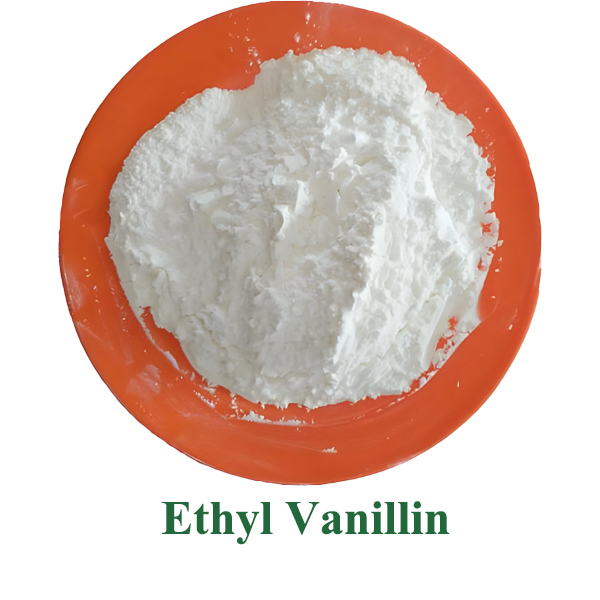
Baisfu Food Grade Ethyl Vanilla Vegetarian Flavoring 99% Natural Flavoring Agent Food Additive
-
Highlight
food grade ethyl vanilla flavoring
,vegetarian natural flavoring agent
,99% natural food additive
-
Product NameEthyl Vanilla
-
CAS121-32-4
-
Purity99.9%
-
AppearanceLiquid
-
Shelf Life2 Years
-
MOQ5KG
-
PackingFoil Bag,Bottled,Drum,Carton,Container
-
QualityNatural Raw Materials, Safe And Harmless, No Addition
-
Boiling Point74-77 °C (lit.)
-
Density1.1097 (rough Estimate)
-
EINECS204-464-7
-
Place of OriginShaanxi, China
-
Brand NameBaisfu
-
CertificationEthyl Vanilla
-
Model Number121-32-4
-
Minimum Order Quantity5kg
-
Price25.59USD
-
Packaging DetailsFoil bag,Bottled,Drum,Carton,Container
-
Delivery Time10-15 work days
-
Payment TermsT/T,Western Union,D/P,L/C
-
Supply Ability20,000 kilograms a month
Baisfu Food Grade Ethyl Vanilla Vegetarian Flavoring 99% Natural Flavoring Agent Food Additive
Ethyl vanillin is a synthetic aromatic compound (chemical formula C₉H₁₀O₃). As an ethylated derivative of natural vanillin, it is one of the most widely used synthetic flavorings globally. Its core characteristic is a richer and longer-lasting vanilla aroma than methyl vanillin, while also possessing advantages such as high stability and wide compatibility. It is widely used in food, daily chemical, and other fields, and is a classic vanilla flavoring raw material that combines high cost-effectiveness and strong functionality.
Chemical Composition: A single chemical substance; commercial products typically have a purity ≥99%. Its chemical name is 3-ethoxy-4-hydroxybenzaldehyde. It has a well-defined structure without complex mixed components, and its purity is highly controllable.
Physical Properties: At room temperature, it is a white crystalline powder or needle-like crystal with a strong, rich vanilla aroma, approximately 3-4 times stronger and longer-lasting than methyl vanillin. Its melting point is approximately 77-79℃, and its boiling point is approximately 285℃. It is slightly soluble in water, readily soluble in ethanol, oils, and most organic solvents, and is highly compatible with food ingredients and daily chemical formulations.
Chemical Properties: Excellent stability; it does not easily decompose in neutral or weakly acidic environments; it is heat-resistant (withstanding baking and frying processes above 200℃), freeze-thaw resistant, and has strong antioxidant properties. It maintains stable aroma and is not easily deteriorated within the product's shelf life.
| Product Name | Ethyl vanillin |
| CAS | 121-32-4 |
| EINECS | 204-464-7 |
| Type | Food Flavors |
| Brand Name | BAISIFU |
| Appearance | Power |
| Shelf Life | 2 years |
| MOQ | 5KG |
| Origan | Shaanxi,China |
| Purity | 99% |
| Packing | Foil bag,Bottled,Drum,Carton,Container |
| Storage | Sealed in dry,Room Temperature |
| density | 1.1097 (rough estimate) |
-
Food and Beverage Sector
Food Flavoring: Widely used in confectionery (chocolate, milk candy, hard candy), baked goods (cakes, biscuits, bread, pastries), ice cream, jelly, yogurt, dairy products, and meat products (such as sausages and ham). A small amount is enough to impart a rich vanilla flavor, enhance product sweetness, and mask any off-odors from raw materials.
Beverage Blending: Used in carbonated beverages, fruit juices, dairy beverages, coffee, tea beverages, and alcoholic beverages (such as whiskey, cocktails, and fruit wines) to enrich the flavor profile and enhance the richness of the aroma.
Food Flavor Blending: As a core vanilla ingredient, it is used in blends of cream, chocolate, fruit, and nut flavorings to meet the flavor enhancement needs of various food production processes.
-
Daily Chemicals and Fragrance Sector
Personal Care Products: Added to shampoos, shower gels, body lotions, hand creams, laundry detergents, fabric softeners, etc., to impart a delicate and long-lasting vanilla fragrance, improve the user experience, and mask any off-odors from chemical raw materials.
Fragrance Products: Used in air fresheners, scented candles, reed diffusers, car air fresheners, etc., featuring a warm and soothing vanilla scent to create a comfortable and relaxing atmosphere.
Makeup and Perfume: Used in small amounts in lipsticks, lip glosses, foundations, perfumes, etc., imparting a subtle vanilla base scent and enhancing the product's luxurious feel and ease of use.
- Rich and long-lasting aroma with an excellent sensory experience: The vanilla aroma is more mellow and penetrating than methyl vanillin. A small amount is sufficient to achieve a significant aroma-enhancing effect, and the scent lasts longer, improving the complexity and persistence of the product's aroma. The aroma concentration is also easier to control compared to natural vanillin.
-
Excellent physicochemical properties and wide applicability:
Superior stability: Better temperature and acid/alkali resistance than natural vanillin and some synthetic vanillin derivatives. It exhibits minimal aroma loss during various food processing (baking, frying, sterilization) and daily chemical production, making it suitable for complex processes.
Good solubility: Easily soluble in oils, ethanol, and other solvents, it can be evenly dispersed in different systems such as food, skincare products, and pharmaceuticals without affecting the original texture of the product (e.g., food taste, makeup adherence).
-
Significant cost advantages and stable supply: The artificial synthesis process is mature (obtained through ethylation and oxidation reactions using guaiacol, glyoxylic acid, etc. as raw materials). Raw materials are readily available and produced in large quantities. The price is only 1/50 to 1/30 of that of natural vanillin, while offering higher aroma intensity and lower unit cost, meeting the needs of large-scale industrial production.
High safety and strong compliance: It complies with the food additive and daily chemical fragrance standards of most countries and regions worldwide, including GB 2760 and the FDA. When used within the prescribed dosage, it is non-toxic, non-irritating, and non-allergenic to humans, with virtually no restrictions on its application scope.





Overall Rating
Rating Snapshot
The following is the distribution of all ratingsAll Reviews